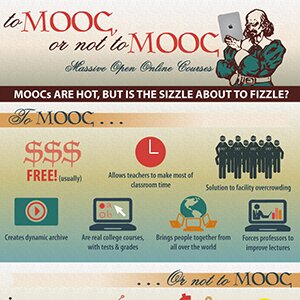MOOCs are hot, but is the sizzle about to fizzle?
A short history of distance learning:
1890s: Correspondence Courses
1920: 4 million people took correspondence courses
1993: Jones International University becomes first online U. [in the world]
2006: Massive Open Online Courses (MOOCs) coined in 2008 by Canadians Dave Cormier and Bryan Alexander
2012: The MOOC market explodes:
5 million: number of students enrolled in Coursera. 325 courses offered.
$63 million: total amount of investment funding in Coursera
1.6 million students in 200 countries enrolled in Udacity. 26 courses offered.
370,000: first year enrollment in edX. Offers 94 courses
$60 million: funding amount for edX, an MIT and Harvard project
Some new MOOCs: :
• San Francisco-based NovoEd is now offering courses directly from Stanford Business School.
• Berlin-based iversity is offering a wide range of courses from European educational institutions.
• Edraak, will be a MOOC portal for the Arab world
• In China – XuetangX
• France: Universite Numerique
Countries of origin: [where the MOOCs are coming from] :
• U.S.: 28%
• U.K. 11%
• India: 4.6%
• Brazil: 4.5%
• Canada: 4%
• Spain: 3.9%
• Australia: 3.5%
• Greece: 2.2 %
• Russia: 1.9%
• Germany: 1.8%
Why all the investment interest? :
• 2 billion potential learners around the world
• More than 70 percent of them cannot afford a college degree
• $400 billion: amount of money spent annually in U.S. on universities
• The $400 billion: more than the annual revenues of Amazon, Apple, Facebook, Google, Microsoft, and Twitter combined.
• 10 million: number of students who have taken at least one MOOC
FACT: mooc.org: Google is teaming up with EdX, to create mooc.org — a You Tube for MOOCs. It will be open to everyone, including businesses, governments, and private individuals.
BUT: 30% of employers believe a MOOC course represents a valid completion – Even so, that’s a major achievement.
To MOOC: :
• Most MOOCs are free or nearly free, a definite plus for the student.
• Provides a solution to overcrowding.
• Forces professors to improve lectures.
• Creates a dynamic archive.
• MOOCS are real college courses, complete with tests and grades.
• Brings people together from all over the world.
• Allows teachers to make the most of classroom time in blended classes. In a “flipped classroom,” teachers send students home with assignments to listen to or watch a recorded lecture
Or not to MOOC:
• It’s not about you, it’s about Money, Money, honey
• The motivation behind MOOCs is corporate profiteering.
• It’s part of a cost-cutting agenda to privatize public higher education
• MOOCs are the leading edge of the Wal-Martification of higher education.
• MOOCs create a two-tier education system.
• A “real” education for those who can afford to pay
• A bargain basement education for those able to only afford online options
• MOOCs are inferior
• they lack interpersonal exchange
• MOOCs are mechanistic
• education’s core values reducing to a mechanistic information-delivery process
• MOOCs are suffering from innovation exhaustion
• The sizzle will fizzle
• 93: failure rate percentage of students enrolled in MOOCs
• 150,000 to 1. Student to teacher ratio. Is that any way to learn? Grading papers is impossible.
That is the question.
Universities (paid) fight back:
Top 10 elite schools ALSO offer MOOCs
• Udemy: professors from universities like Dartmouth, the University of Virginia and Northwestern
• iTunes U: Apple’s free app “gives students access to all the materials for courses in a single place.
• Stanford:
• FACT: 160,000 students from 190 countries signed up to Stanford’s Introduction to AI” course, with 23,000 reportedly completing.
• UC Berkeley
• MIT
• Duke
• Harvard
• UCLA
• Open Yale
• Carnegie Mellon
And now there are
SPOCs: Small Private Online Courses :
• New B-to-B concept: license online courses to a university or an organization or corporation.
• Colorado State Global Campus, first to offer SPOCs
• SPOCs have 17-25 students
Sources:
http://www.educause.edu/ero/article/five-myths-about-moocs
http://www.insidehighered.com/news/2013/07/09/higher-ed-leaders-urge-slow-down-mooc-train
http://edf.stanford.edu/readings/mooc-marketplace-takes
http://www.edtechmagazine.com/higher/article/2013/02/11-enlightening-statistics-about-massive-open-online-courses
http://adulted.about.com/od/Adult-Education-in-the-U.S./a/The-Pros-And-Cons-Of-Moocs.htm


